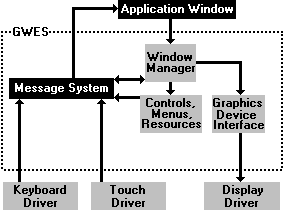
The Graphics Windowing and Event Subsystem (GWES) is the graphical user interface between the user, your application, and the operating system. GWES handles user input by translating keystrokes, stylus movements, and control selections into messages that convey information to applications and the operating system. GWES handles output to the user by creating and managing the windows, graphics, and text that are displayed on display devices and printers.
GWES supports all the windows, dialog boxes, controls, menus, and resources that make up Windows CE user interface. This interface allows users to control applications by choosing menu commands, pushing buttons, checking and unchecking boxes, and manipulating a variety of other controls. GWES provides information to the user in the form of bitmaps, carets, cursors, text, and icons.
Even Windows CE-based platforms that lack a graphical user interface use GWES basic windowing and messaging capabilities. These provide the means for communication between the user, the application, and the operating system.
As part of GWES, Windows CE provides support for active power management to extend the limited lifetime of battery-operated devices. The operating system automatically determines a power consumption level to match the state of operation of the device.
The following illustration describes the basic GWES structure.

GWES structure